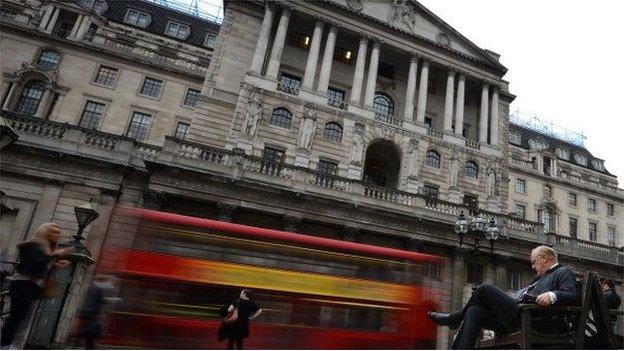The risks stalking the UK economy
- Published
- comments

The Bank of England's key message is that the City's big banks are in a resilient state
Managing risk is a balancing act. Be too risk-averse and there is danger of creating the "stability of the graveyard".
Yes, banks would be stable and safe, but they would not be lending sufficiently to the real economy or supporting growth.
On the other side, no one wants to see a return to the chaos of the financial crisis when banks were stuffing themselves to the point of sickness in a world of ever increasing, cheap credit.
Before 2007, risk was so misunderstood, at the first sign of financial stress a number of banks blew up.
And the global financial sector nearly ground to a halt.
Today, the Bank of England has produced two reports dealing with the issue of financial stability.
Its key message? That the UK's major banks are in a relatively resilient state and that the need for ever higher regulatory controls is coming to an end.
Yes, the Royal Bank of Scotland and Standard Chartered had to do some work to strengthen their position.
But no-one failed the stress test.
'Long march'
This is an "inflection point" in the post-financial world - a new chapter, the Bank signalled.
The Bank does not believe in a "long march to ever more capital". And it feels that banks are now handling risk more prudently.
Since the financial crisis, the amount of capital banks hold (a measure of the robustness of their balance sheet) has increased substantially.
Banks also now have what are called "resolution plans" - processes that are triggered during a crisis, which will supposedly allow a bank to be wound down without threatening the whole financial system.
The Bank, of course, does not want banks to sit back on their deck chairs, put their pedicured feet up and light a cigar.
So, it has laid out what it thinks are the major risks to the UK economy. And it wants the banks to take note.
First, the Bank highlights what it describes as "emerging market risk". Britain's banks have large scale exposure to private sector debt across Asia, for example.
If there is a significant downturn in those economies, which some predict, those exposures could weigh heavily on the UK banks' balance sheets.
Second, is the global risk associated with the first rise in interest rates since the financial crisis.
Interest rates could rise in America before the end of the year. And rates could increase in the UK during next year.
The Bank warns that this could increase market volatility, as cash and investments move to higher interest rate jurisdictions in a hunt for higher yields.
Turning to the UK, the Bank says that the buy-to-let and the commercial property markets are rising up the risk register.
Since 2008, buy-to-let lending by banks has increased by 5.9% a year.
Riskier lending
The Bank says that such lending is less cautious than the overall mortgage market, with higher loan-to-value thresholds.
"It may have implications for financial stability," the Bank says. The Prudential Regulation Authority, an arm of the Bank, is now reviewing the sector.
The Bank also warns on the commercial property market - one sector that played a starring role in the financial crisis.
"Prices in the UK commercial real estate market have risen significantly and the funding of investments is becoming riskier," the Bank said.
Now, some slightly riskier lending might be a good thing to support economic growth.
But the Bank is warning the major banks now - take care with that risk.
Because, though the Bank does not want the stability of the graveyard, it also does not want to see the 2007 financial crisis all over again.
- Published1 December 2015
